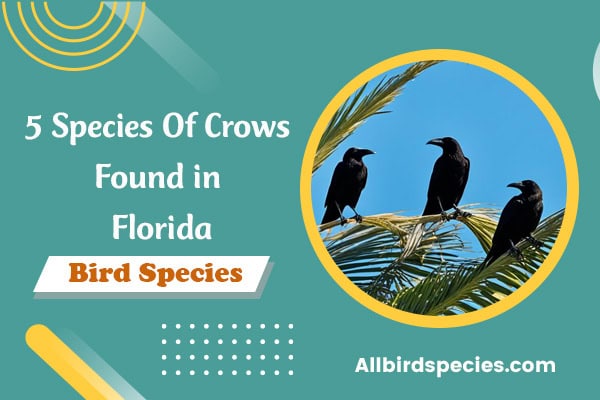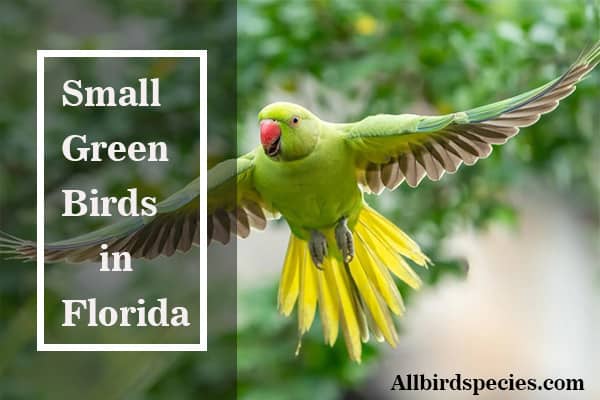10 Black and White Birds in Michigan: Identification and Habitats
Michigan is a haven for bird watchers, boasting many bird species across its varied landscapes, including black and white birds. They stand out not only for their striking appearance but also for their unique behaviors and habitats. This article will explore 10 black and white birds in Michigan, providing identification tips, insights into their habits, and the best locations to spot them. Understanding these species is crucial for birdwatchers and conservationists alike, as it fosters appreciation for Michigan’s avian biodiversity and encourages efforts to protect their habitats.
1. Downy Woodpecker
The Downy Woodpecker is a small, charismatic bird with black wings marked by white spots and a pure white belly. Its small size, along with its black-and-white coloration, can make it difficult to distinguish from other woodpecker species. However, the Downy Woodpecker’s short bill is a key identifier.

Identification:
- Size: Small (6-7 inches long)
- Plumage: Black wings with white spots, a white belly, and a black stripe running down the head.
- Sound: Known for its rapid drumming on tree trunks, it also produces a sharp “pik” sound.
Habitat and Behavior:
This woodpecker is a frequent visitor to woodlands, urban areas, and backyard feeders, especially where suet and seeds are offered. Downy Woodpeckers nest in tree cavities and are often seen foraging for insects by tapping on bark.
Where to Spot Them: Look for these birds in forests and wooded areas, especially around dead trees where they nest. During the winter months, you may also spot them at backyard feeders.
2. Black-capped Chickadee
The Black-capped Chickadee is a beloved bird in Michigan, easily recognizable by its black cap and bib, white cheeks, and gray wings. These small birds are known for their curious and friendly nature, often approaching bird feeders without hesitation.
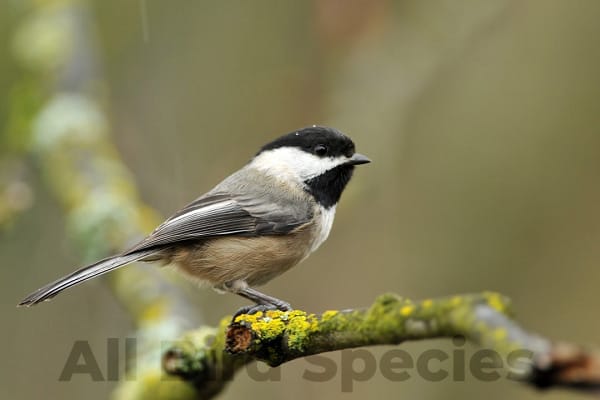
Identification:
- Size: Small (4-5 inches long)
- Plumage: Black cap and bib, white cheeks, gray wings, and a short bill.
- Sound: Famous for their “chick-a-dee-dee-dee” call and high-pitched whistles.
Habitat and Behavior:
Chickadees are year-round residents in Michigan, with their populations swelling in winter when they flock to feeders. They are often seen in mixed forests, where they forage for insects, seeds, and berries. Chickadees are also cavity nesters and will use birdhouses if placed in quiet, wooded areas.
Where to Spot Them: Chickadees are frequently found in forests, parks, and backyards with feeders. They are particularly active in winter.
3. Northern Mockingbird
The Northern Mockingbird stands out not only for its sleek black and white plumage but also for its remarkable ability to mimic the songs of other birds. Its black wings and white patches are easy to spot when it’s in flight.
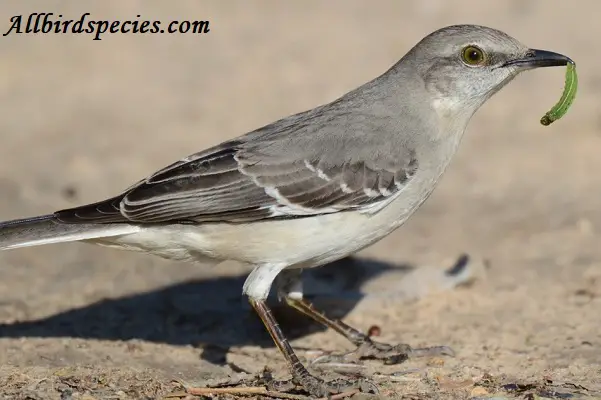
Identification:
- Size: Medium (8-10 inches long)
- Plumage: Gray body with black wings and white wing patches. Long tail feathers tipped with white.
- Sound: Known for its extensive vocal mimicry, often incorporating songs from other species into its repertoire.
Habitat and Behavior:
Mockingbirds often sing from high perches in urban, suburban, and open areas. They are fiercely territorial and can be seen chasing away intruders. Their diet includes insects and berries.
Where to Spot Them: Northern Mockingbirds prefer open habitats and are commonly seen in parks, gardens, and suburban areas.
4. Common Loon
The Common Loon is a striking black-and-white water bird that can be spotted on Michigan’s many lakes during the summer months. Its eerie calls can often be heard echoing across the water.
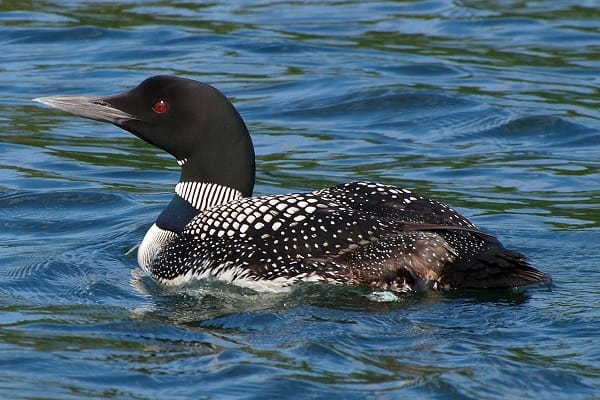
Identification:
- Size: Large (24-32 inches long)
- Plumage: Black head with a white checkered pattern on its back and white belly.
- Sound: Famous for its haunting wails, yodels, and tremolos.
Habitat and Behavior:
Loons are expert divers, hunting fish underwater using their powerful legs and sharp beaks. They breed on freshwater lakes and nest near the water’s edge. Michigan serves as an important breeding ground for these birds, which migrate south in the winter.
Where to Spot Them: Loons are commonly found on large lakes, particularly in northern Michigan during the summer.
5. White-breasted Nuthatch
The White-breasted Nuthatch is known for its unique behaviour of moving headfirst down tree trunks as it forages for insects hidden in the bark. This bird is often seen in Michigan’s forests and backyards.
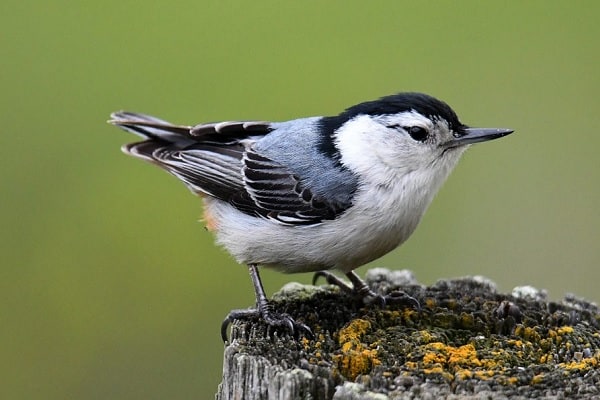
Identification:
- Size: Small (5-6 inches long)
- Plumage: Black cap, white face, and gray back with a white belly.
- Sound: A nasal “yank” call.
Habitat and Behavior:
White-breasted Nuthatches are common in mature forests and residential areas with large trees. They feed on seeds, insects, and nuts, and are frequent visitors to bird feeders. Their acrobatic movements along tree trunks make them easy to spot.
Where to Spot Them: Look for these birds in forests, especially those with large deciduous trees, as well as at backyard feeders.
6. Red-headed Woodpecker
The Red-headed Woodpecker is one of Michigan’s most striking birds, with a bold red head contrasting sharply against its black wings and white body.

Identification:
- Size: Medium (7-9 inches long)
- Plumage: Bright redhead, black wings, and white belly.
- Sound: A harsh “queer” or “churr” sound.
Habitat and Behavior:
These woodpeckers prefer open woodlands and are often found foraging on dead trees or stumps. They are known for their aggressive territorial behavior and their habit of storing food, particularly acorns, in tree cavities.
Where to Spot Them: Red-headed Woodpeckers are often found in open forests, especially areas with dead trees or open spaces.
7. Eastern Kingbird
The Eastern Kingbird is a bold bird with black and white plumage. It is known for aggressively defending its territory against larger birds.

Identification:
- Size: Medium (7-9 inches long)
- Plumage: Black back, white belly, and black tail with a white tip.
- Sound: Sharp, high-pitched calls.
Habitat and Behavior:
Eastern Kingbirds are often found in open areas, such as fields and along forest edges, where they perch on high branches to spot insects in flight. They are migratory, travelling to South America for the winter.
Where to Spot Them: Eastern Kingbirds are commonly seen in open habitats during the breeding season.
8. Dark-eyed Junco
The Dark-eyed Junco is a common winter visitor in Michigan, easily identified by its dark slate-colored back and head contrasted by a white belly.
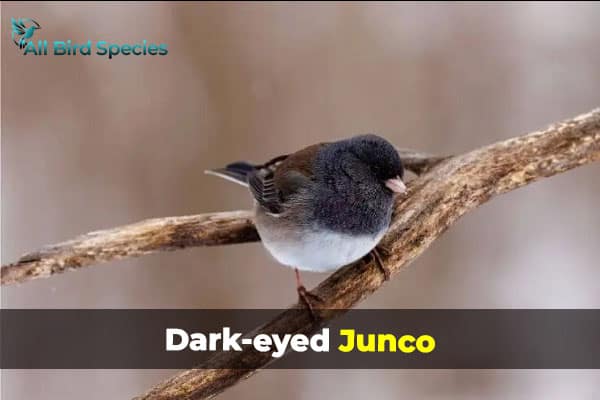
Identification:
- Size: Small (5-6 inches long)
- Plumage: Dark grey or slate-coloured body with a white belly.
- Sound: A soft, high-pitched trill.
Habitat and Behavior:
Juncos are ground feeders, often seen hopping along the forest floor or in backyards looking for seeds. They are most abundant in Michigan during the winter, where they flock to bird feeders.
Where to Spot Them: Dark-eyed Juncos are common in forests and residential areas during the colder months.
9. Belted Kingfisher
The Belted Kingfisher is a distinctive bird found near bodies of water. It hunts for fish by diving from a perch.

Identification:
- Size: Medium (11-14 inches long)
- Plumage: Black head, white belly, and blue-grey wings.
- Sound: A loud, rattling call.
Habitat and Behavior:
Belted Kingfishers are typically found along rivers, lakes, and streams, perched on branches over the water. They dive headfirst to catch fish, using their sharp beaks to snatch their prey.
Where to Spot Them: Look for Belted Kingfishers near rivers and lakes, where they are often seen patrolling the water’s edge.
Conclusion
Michigan has a diverse array of black and white bird species, each with unique characteristics and behaviors. From the acrobatic Downy Woodpecker to the striking Common Loon, these birds contribute to the rich tapestry of Michigan’s avian life. Birdwatchers are encouraged to participate in local conservation efforts to protect these species and their habitats. Creating bird-friendly environments in your backyard, such as providing feeders, water sources, and native plants, can significantly impact local bird populations. We can ensure their continued presence in Michigan’s beautiful landscapes by fostering an appreciation for these black and white birds. Whether you’re a seasoned birdwatcher or a casual observer, watch for these remarkable species and enjoy the beauty they bring to our natural world.
Note: Always remember to respect bird habitats and support local conservation efforts by planting native species and providing safe feeding stations. This will contribute to the preservation of Michigan’s diverse bird population for future generations.
Frequently Asked Questions About Michigan’s Black and White Birds
Q1: What Michigan birds have black and white heads?
The Black-capped Chickadee is the most notable bird in Michigan with a black and white head.
Q2: What kind of bird is a black and white bird?
Various black and white birds inhabit Michigan, including the Black-capped Chickadee, Hairy Woodpecker, and Black-and-white Warbler.
Q3: What is the most common bird in Michigan?
The American Robin is the most common bird in Michigan, often seen in gardens and open spaces.
Q4: What is a white bird with black-tipped wings in Michigan?
The Eastern Kingbird is a white bird with black-tipped wings found in Michigan.
Q5: What are the rare birds in Michigan?
Some rare birds in Michigan include the Kirtland’s Warbler, Piping Plover, and the Red-necked Grebe. Keep in mind that bird populations can vary, and rarity may change over time.


